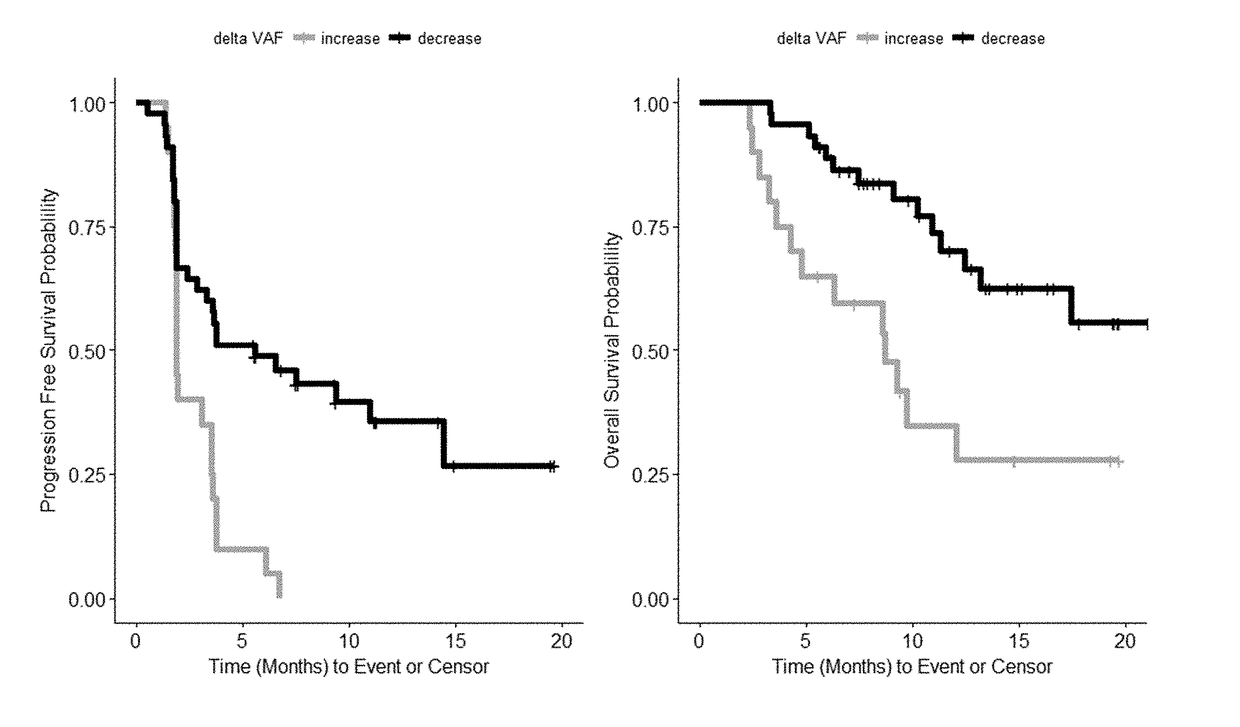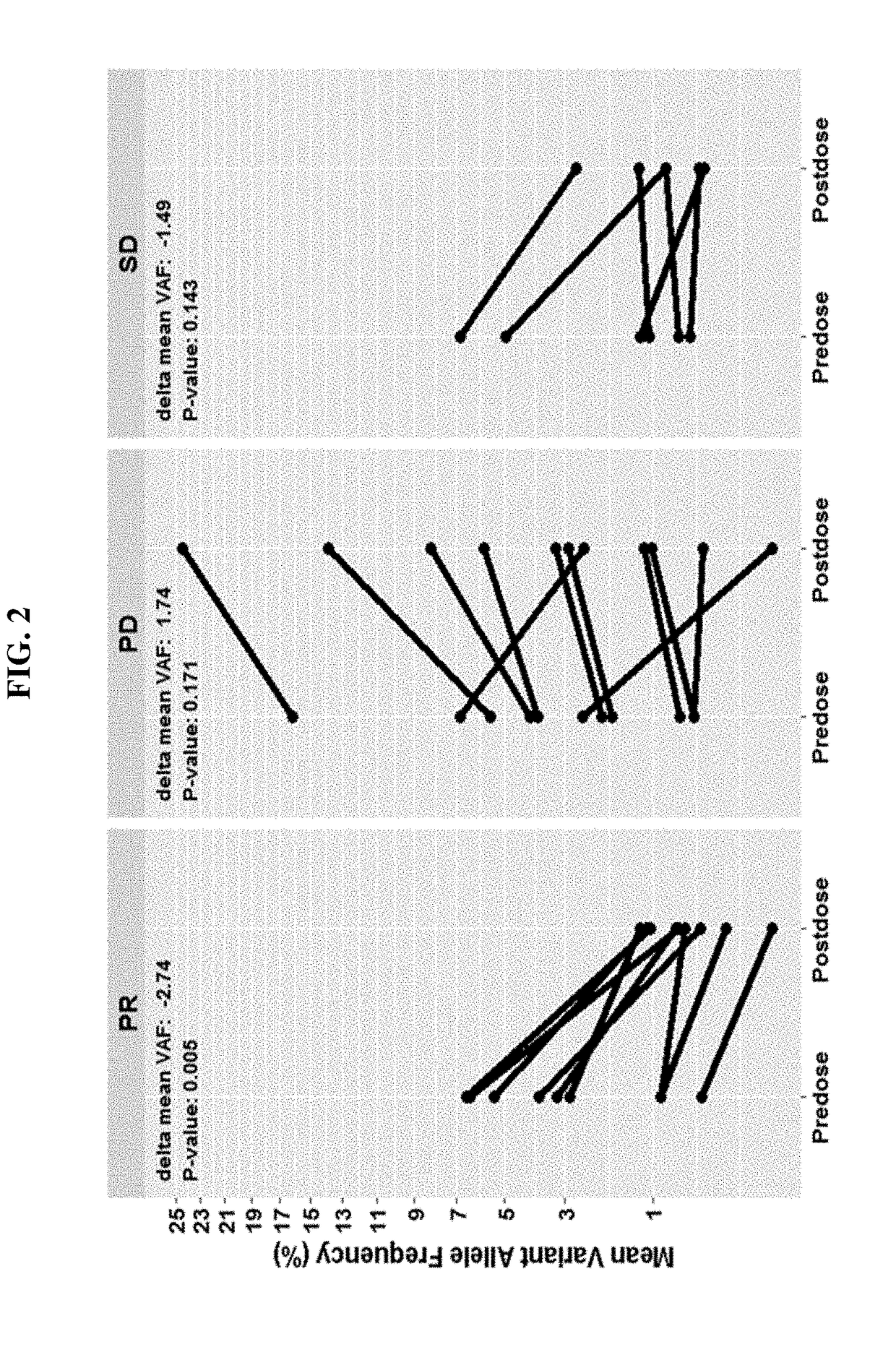Tumor burden as measured by cell free DNA
a cell-free dna and tumor burden technology, applied in the direction of antibody medical ingredients, drug compositions, peptides, etc., can solve the problems of ineffective clearing in response to exhaustive exercise, cancer remains a major cause of death, etc., to achieve a longer progression free survival, overall survival, and greater chance
- Summary
- Abstract
- Description
- Claims
- Application Information
AI Technical Summary
Benefits of technology
Problems solved by technology
Method used
Image
Examples
example 1
Decrease in ctDNA Mean Variant Allele Frequency Observed in Responding NSCLC Patients
[0125]Analysis of patient samples confirms that ctDNA is detectable in cell-free DNA isolated from plasma. Analysis of samples obtained from 116 patients during screening identified variants in 96% of the samples (111 / 116), with several frequently observed variants, including TP53 (69% of samples), PIK3CA (29% of samples), EGFR (28% of samples), KRAS (24% of samples), and CDKN2A (16% of samples). See FIG. 1.
[0126]Changes in mean variant allele frequencies (VAF) during the course of therapy correlates with disease progression. Responding patients (PR) have a significant decrease (−1.6%, p=0.008) in ctDNA VAF after 4 doses / treatments while non-responders have an observable increase in mean VAF (+1.4%, p=0.05). See FIG. 2 which includes SNVs and indels with allele frequency ≥0.3% at screening and depicts the PFS probability and OS probability for patients exhibiting a mean decrease or increase in VAF a...
example 2
Decrease in ctDNA Mutation Burden Observed in Responding NSCLC Patients
[0130]In addition to the decrease in mean VAF discussed in Example 1, responding patients (PR) exhibit a significant decrease in mutation burden as determined by total mutation counts (average difference of −5.3, p=0.037, and ci(95%)=−10.2, −0.4) after 8 weeks of treatment when compared to non-responding (PD / SD) patients (average difference of +1.6, p=0.036, ci(95%)=0.1, 3.1). See FIG. 4 which plots the total mutation count at screening (predose) and after dose 4 administered at week 6 (postdose).
example 3
New ctDNA Mutations are Associated in Patients with Progressive NSCLC
[0131]New ctDNA mutations are detected in 100% of PD patients after 8 weeks (4 doses), compared to 57% of patient classified as SD and 56% of patients classified as PR. See FIG. 5. The new mutations detected in PR patients (5 / 9) do not include driver mutations common to NSCLC, while driver mutations common to NSCLC were detected in 42% of PD patients (5 / 12) and 14% of SD patients (1 / 7). As such, during the course of therapy detection of mutations absent at screen are more likely to be associated with non-responder (PD) patients. FIG. 6 provides examples of new driver mutations appearing in two non-responder patients (EGFR, TP53(S215R), and ALK(M1302T); and TP53(p.Gln375fs), KRAS(G12C), and TP53(T125T)).
[0132]Further analysis of the data identified that several ctDNA variants which can be detected at baseline (screen) are associated with responders, including BRCA1, BRCA2, PIK3CA, NFE2L2, NOTCH1, SMAD4, and KRAS and...
PUM
| Property | Measurement | Unit |
|---|---|---|
| Time | aaaaa | aaaaa |
| Time | aaaaa | aaaaa |
| Dimensionless property | aaaaa | aaaaa |
Abstract
Description
Claims
Application Information
 Login to View More
Login to View More - R&D
- Intellectual Property
- Life Sciences
- Materials
- Tech Scout
- Unparalleled Data Quality
- Higher Quality Content
- 60% Fewer Hallucinations
Browse by: Latest US Patents, China's latest patents, Technical Efficacy Thesaurus, Application Domain, Technology Topic, Popular Technical Reports.
© 2025 PatSnap. All rights reserved.Legal|Privacy policy|Modern Slavery Act Transparency Statement|Sitemap|About US| Contact US: help@patsnap.com



